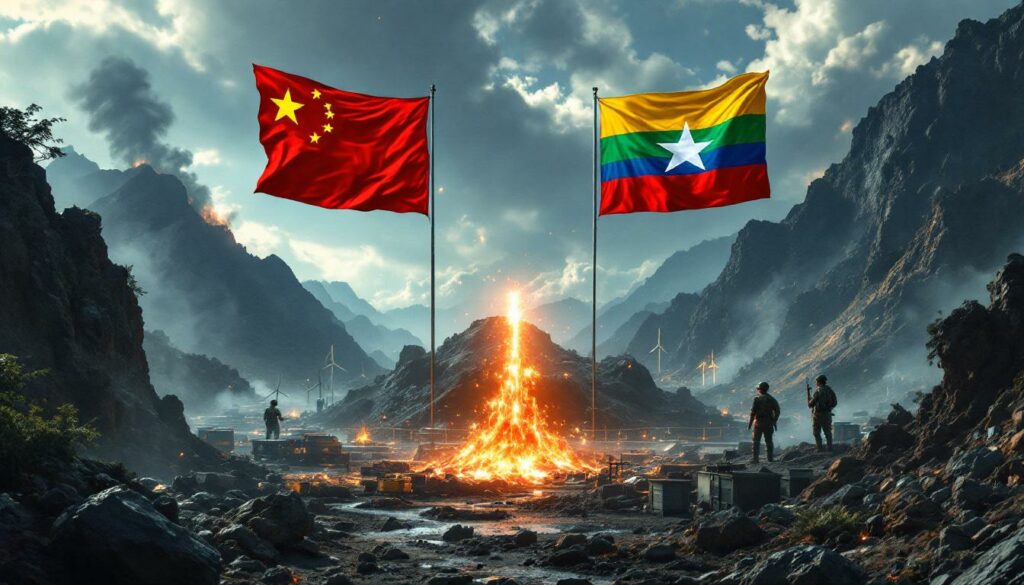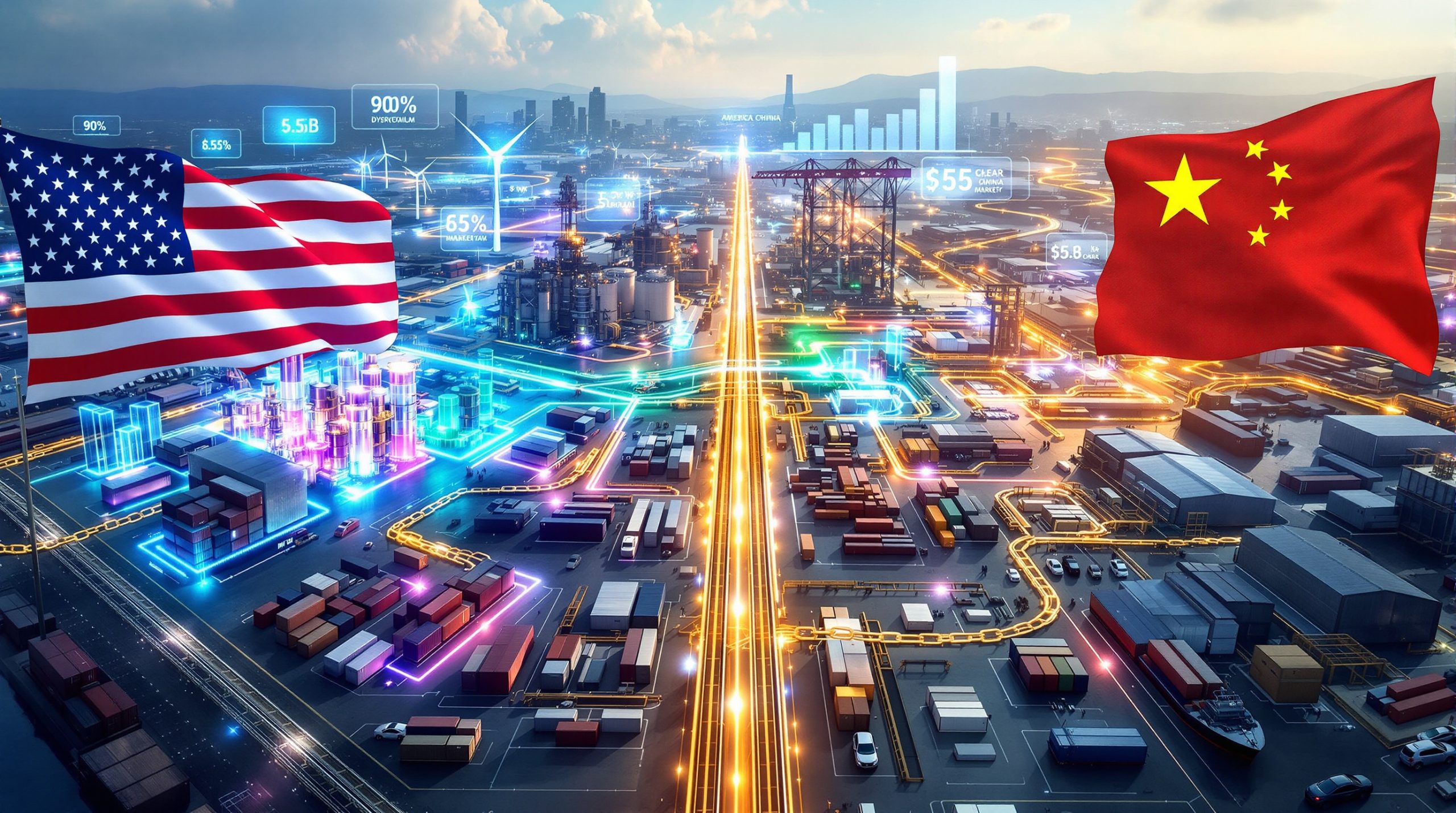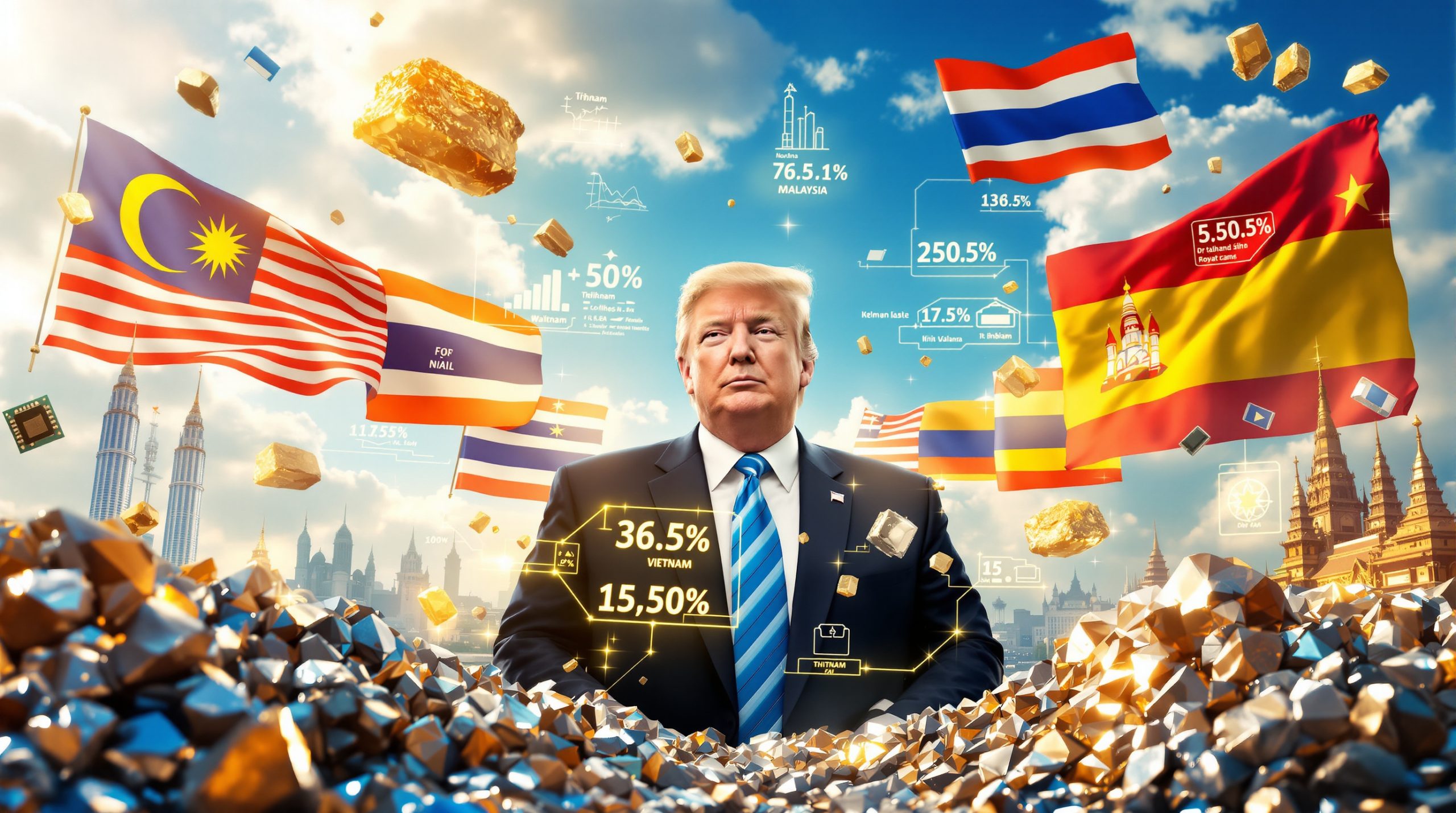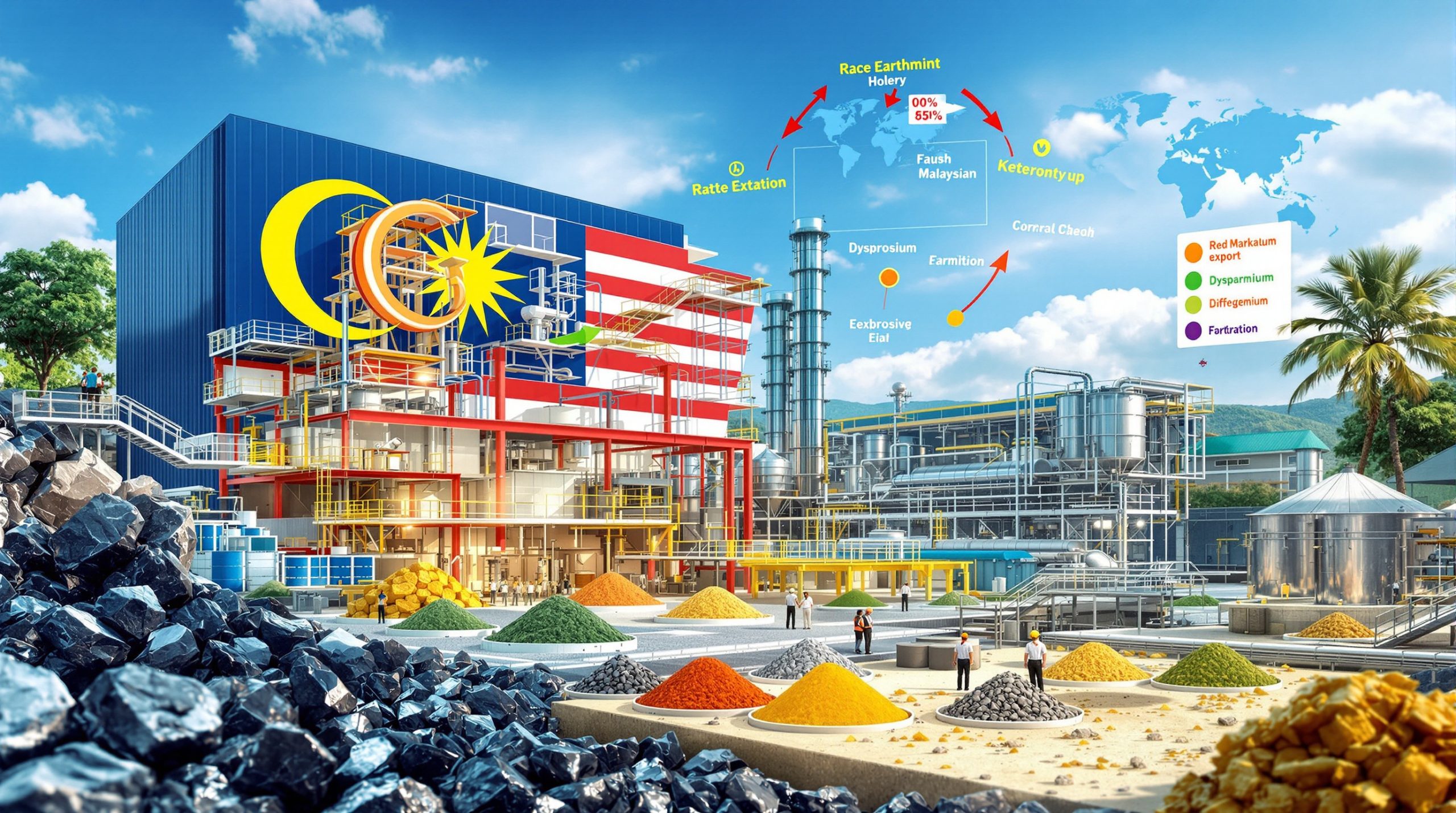China's Rare Earth Ultimatum: How Geopolitical Tensions Threaten Global Supply Chains
The battle for control of northern Myanmar has escalated into a high-stakes geopolitical confrontation with global implications for critical mineral supplies. Since December 2024, the Kachin Independence Army (KIA) has been fighting Myanmar's military junta for control of Bhamo, a strategic town less than 100 km from the Chinese border. This conflict directly threatens nearly half the world's supply of heavy rare earth elements, which are essential for manufacturing electric vehicle motors and wind turbines.
According to multiple intelligence sources, China has intervened in this conflict with an unusual strategy: leveraging its dominant position in rare earth processing to pressure rebel forces, while simultaneously working to secure its supply chains. This complex geopolitical chess game demonstrates China's willingness to use resource control as leverage in regional conflicts.
The Strategic Importance of Kachin State
Kachin state houses crucial mining operations that produce dysprosium, terbium, and other heavy rare earth elements. These minerals are extracted from mines north of Bhamo and transported to China for processing. The region's strategic value extends beyond minerals – Bhamo serves as a vital logistics hub for the military junta, with its 166,000 residents caught in the crossfire of this intensifying conflict.
The area's unique geology makes it particularly valuable. Kachin's rare earth deposits occur primarily in ion-adsorption clay formations, which are significantly easier to mine and process than hard-rock deposits found elsewhere. These clay deposits yield higher concentrations of heavy rare earths—the most valuable and scarce subset of these critical elements.
"The concentration of heavy rare earths in Kachin's clay deposits makes them economically irreplaceable in the short term," notes Dr. Julie Thompson, rare earth specialist at the Critical Minerals Institute. "Unlike light rare earths, which are more widely available, heavy rare earths remain geographically concentrated in just a few regions globally."
How the KIA Gained Control of Rare Earth Mining Areas
In October 2024, the KIA successfully seized control of the main rare earth mining belt in Kachin state. Following this territorial gain, the rebel group:
- Increased taxes on mining operations by approximately 30%
- Restricted production volumes of critical minerals to 60% of previous capacity
- Disrupted established supply chains to China by implementing new border checkpoints
- Implemented stricter environmental oversight of previously unregulated operations
These actions triggered significant market responses, with terbium prices skyrocketing from $1,200 per kilogram to over $1,950 per kilogram in just eight weeks. Global manufacturers of high-performance magnets began reporting supply shortages by early 2025.
How Is China Using Rare Earths as Geopolitical Leverage?
China has leveraged its near-monopoly on rare earth processing to influence the conflict's outcome. According to multiple sources familiar with the situation, Chinese officials issued an ultimatum to the KIA during meetings in early 2025.
The timing of China's intervention is particularly significant as it follows Beijing's separate move to restrict rare earth exports globally in spring 2025—a decision made in retaliation for US–China trade impacts. This demonstrates China's dual-track approach to rare earth diplomacy: using export controls as leverage against Western competitors while simultaneously working to secure upstream supply.
China's Ultimatum to Kachin Rebels
China's demands to the KIA included:
- Abandoning efforts to seize full control of Bhamo
- Ceasing military operations against junta forces in the region
- Allowing stabilization of rare earth supply chains
- Permitting mining operations to resume at pre-conflict levels
- Creating a "buffer zone" around key transportation corridors
In exchange, China offered increased cross-border trade opportunities with KIA-controlled territories. However, the threat was clear: if the KIA continued its offensive, China would halt purchases of rare earth minerals from KIA-controlled areas.
"China, which needs rare earths, can only tolerate this for a limited time," a KIA commander told Reuters on condition of anonymity, referring to the supply disruptions.
The Global Impact of China's Rare Earth Strategy
China's approach demonstrates its willingness to use resource control as a geopolitical tool:
- In spring 2025, China restricted rare earth exports globally in retaliation for US tariffs
- These restrictions sent shockwaves through global supply chains, with prices for processed rare earths rising 40% outside China
- Now China is using its market dominance to support Myanmar's military junta
- This approach aims to protect Chinese economic interests in the region, including billions invested in processing facilities
"China's pressure is a more general approach to calming down the conflict," observed David Mathieson, an independent Myanmar analyst. This strategy reveals Beijing's pragmatic approach—supporting the junta while simultaneously engaging with rebel groups to protect economic interests.
A Chinese Foreign Ministry spokesperson maintained that "an early ceasefire and peace talks… are in the common interests" of all parties, without directly addressing questions about China risks global heavy rare earth supply to stop Myanmar rebel victory.
Why Are Heavy Rare Earths So Critical to Global Industries?
Heavy rare earth elements play an irreplaceable role in modern technology, particularly in the critical minerals transition. Unlike their lighter counterparts, heavy rare earths possess unique magnetic and electronic properties that enable high-temperature stability in permanent magnets—a critical requirement for electric vehicle motors and wind turbines.
Dysprosium and terbium, two key heavy rare earths mined in Kachin, are particularly crucial additives in neodymium-iron-boron (NdFeB) magnets. These additives enable magnets to maintain their performance at the high operating temperatures typical in EV motors, where temperatures can reach 150°C.
Technical Note: Just 2-4% dysprosium content in NdFeB magnets can increase their maximum operating temperature from 80°C to over 200°C while preventing demagnetization—a property no substitute material has yet matched at commercial scale.
The Strategic Value of Myanmar's Rare Earth Production
Myanmar's contribution to global rare earth supply is substantial:
| Period | Myanmar's Exports to China (metric tons) | Year-over-Year Change |
|---|---|---|
| Jan-May 2024 | 25,888 | – |
| Jan-May 2025 | 12,944 | -50% |
| April-May 2025 | – | +20% (month-over-month) |
The disruption in supply has created significant market volatility, with prices for elements like terbium experiencing dramatic fluctuations. The recent 20% month-over-month increase in exports coincides with China's ultimatum to the KIA, suggesting the pressure tactics may be yielding results.
Supply Chain Vulnerabilities Exposed
Industry analysts warn that continued disruption could create serious supply deficits:
- "A disruption in the movement of heavy rare earths from Kachin could lead to a deficit in the global market by the end of the year," according to Neha Mukherjee of Benchmark Mineral Intelligence
- Prices outside China could "shoot up higher" during even brief disruption periods
- Alternative supply sources remain severely constrained globally
- Current recycling technologies recover less than 1% of rare earths from end-of-life products
The concentration of heavy rare earth production in Myanmar represents a critical vulnerability in global supply chains. Unlike light rare earths, which are mined in several countries, heavy rare earths remain geographically concentrated, with Myanmar and southern China controlling the vast majority of economically viable deposits.
Who Are the Key Players in Myanmar's Rare Earth Conflict?
Understanding the motivations and capabilities of the main actors provides crucial context for the conflict's potential outcomes.
The Kachin Independence Army (KIA)
Founded in 1961, the KIA fights for the autonomy of Myanmar's Kachin minority and has established itself as one of the country's most formidable rebel groups:
- Estimated force strength: Over 15,000 personnel
- Funding sources: Local taxation and natural resource control
- Strategic advantages: Decades of combat experience and local support
- Current objective: Capture Bhamo to strengthen territorial control
The KIA has demonstrated sophisticated military capabilities, including the use of drones for reconnaissance and targeting. Their deep knowledge of local terrain gives them a significant advantage in the mountainous border regions where rare earth mining takes place.
"We know the mountains better than anyone. This is our home," a KIA field commander told reporters during a rare media tour of captured mining areas in January 2025.
Myanmar's Military Junta
Since overthrowing the democratically elected government in 2021, the military junta has faced nationwide armed rebellion:
- Increasingly reliant on airpower to maintain control
- Receiving military support from China, including J-7 fighter jets and Wing Loong II drones
- Holding isolated positions in Bhamo after KIA advances
- Using airstrikes that have caused significant civilian casualties
A junta spokesperson acknowledged Chinese influence in the conflict, stating: "China may have exerted pressure and offered incentives to the KIA" to cease their offensive operations.
China's Strategic Interests
China's involvement reflects its complex economic and security interests in Myanmar:
- Protection of rare earth supply chains crucial to its manufacturing sector
- Maintenance of border stability to prevent refugee flows
- Preservation of infrastructure investments under the Belt and Road Initiative
- Preference for military junta as a reliable partner for economic cooperation
Beijing's approach demonstrates a willingness to work with all sides to protect its interests. While officially supporting Myanmar's government, China maintains open channels with rebel groups controlling territories along its border.
What Are the Potential Outcomes of This Conflict?
The battle for Bhamo represents more than just a local conflict—it has significant implications for global supply chains and geopolitical alignments.
Scenario 1: KIA Victory in Bhamo
If the KIA successfully captures Bhamo, potential consequences include:
- Further isolation of junta forces in northern Myanmar
- Disruption of military supply lines along the Irrawaddy River
- Strengthened KIA negotiating position with China
- Potential reconfiguration of rare earth supply arrangements
KIA leaders believe capturing Bhamo would shift momentum in their favor and strengthen public support for their cause. However, such a victory could prompt increased Chinese pressure or even direct intervention to stabilize supply chains.
"China would view a complete KIA victory as threatening to its economic interests," explains Dr. Sarah Williams, Southeast Asia security analyst. "Beijing prefers balanced tensions where both sides remain dependent on Chinese mediation."
Scenario 2: Continued Chinese Pressure Forces Compromise
China's economic leverage could force concessions:
- Border restrictions causing shortages of fuel and medicine in Kachin
- Potential economic blockade severely impacting local populations
- Forced negotiation between KIA and junta under Chinese mediation
- Restoration of rare earth supply chains under new arrangements
Recent data showing a 20% month-over-month increase in rare earth exports from Myanmar to China suggests this scenario may already be unfolding. The KIA's willingness to allow some mining operations to resume indicates China's economic pressure is having an effect.
Scenario 3: Prolonged Conflict Creates Supply Chain Crisis
If fighting continues without resolution:
- Global heavy rare earth deficit by late 2025
- Price spikes for critical minerals exceeding 200% of current levels
- Acceleration of alternative supply development outside China
- Increased investment in rare earth recycling and substitution
- Emergency stockpile releases by countries with strategic reserves
This scenario would trigger emergency measures in countries dependent on rare earth imports. Japan, which maintains a strategic stockpile of rare earths, would likely be better positioned than most to weather short-term disruptions.
How Is the Conflict Affecting Civilians in the Region?
The human cost of the battle for Bhamo has been severe, with civilians bearing the brunt of military operations.
Humanitarian Impact of Military Operations
The junta's airstrikes have:
- Destroyed schools, homes, and places of worship in densely populated areas
- Killed civilians, including children, with documented cases of cluster munition use
- Created internal displacement affecting approximately 30,000 people
- Damaged critical infrastructure including hospitals and water treatment facilities
According to Khon Ja, a Kachin activist from Bhamo whose home was bombed, existing border restrictions have led to shortages of essential supplies like petrol and medicine.
"First they bomb our homes, then they block medicine from reaching us," she told Reuters. "People are dying from treatable conditions because supplies cannot cross the border."
Environmental and Health Concerns
The rare earth mining operations themselves present additional challenges:
- Environmental degradation from unregulated mining using harsh chemicals
- Potential contamination of water sources with acids used in extraction
- Health risks for mining communities exposed to radioactive thorium often present in rare earth deposits
- Long-term ecological damage in conflict zones where environmental oversight is minimal
Independent environmental assessments of Kachin's mining regions have been impossible due to the conflict, but satellite imagery shows significant forest clearing and watershed disruption around mining operations.
What Does This Mean for Global Rare Earth Supply Chains?
The disruption in Myanmar highlights the vulnerability of global supply chains dependent on geographically concentrated resources.
Short-Term Market Impacts
The immediate effects of the conflict include:
- 50% reduction in Myanmar's rare earth exports to China (Jan-May 2025)
- Price volatility for heavy rare earth elements, with terbium briefly reaching $1,950/kg
- Supply uncertainty for manufacturers of wind turbines and electric vehicles
- Potential stockpiling by major consumers including Japan, South Korea, and Germany
Toyota announced in June 2025 that it was temporarily slowing production of certain hybrid models due to magnet supply constraints. Other manufacturers have reported seeking alternative suppliers or redesigning components to reduce rare earth dependency.
Long-Term Strategic Responses
Countries and companies are likely to respond with:
- Accelerated development of alternative supply sources in Australia, Canada, and the United States
- Increased investment in recycling technologies to recover rare earths from end-of-life products
- Research into material substitution, including iron-nitride magnets for less demanding applications
- Strategic stockpiling of critical minerals by governments and corporations
- Diversification of supply chains away from conflict regions
The U.S. Department of Energy has already increased funding for its Critical Materials Institute by 60% in response to the Myanmar crisis, focusing on recycling technologies and substitute materials. Furthermore, Trump's mineral order has strengthened efforts to develop domestic rare earth capabilities.
How Can Countries Reduce Dependence on Vulnerable Supply Chains?
The Myanmar situation highlights the urgent need for supply chain resilience strategies.
Developing Alternative Sources
Several initiatives are underway to diversify supply:
- Exploration projects in Australia's Northern Territory (Arafura Resources, Peak Resources)
- Expansion of Mountain Pass mine operations in California (MP Materials)
- Canadian projects in Northwest Territories (Vital Metals, Cheetah Resources)
- Greenland's Kvanefjeld project, despite environmental controversies
- Deep-sea mining research targeting Pacific Ocean nodules rich in critical minerals
Important Note: While these projects promise diversification, most focus on light rare earths. Heavy rare earth alternatives remain limited and would require 5-8 years to reach commercial production volumes comparable to Myanmar's output.
Technological Adaptations
Research is advancing on multiple fronts:
- Designing products that require fewer rare earth elements, such as switched reluctance motors
- Improving recycling efficiency for end-of-life products through innovative chemical processes
- Developing synthetic alternatives for critical applications in partnership with national laboratories
- Enhancing material efficiency in manufacturing to reduce waste and consumption
"We're seeing unprecedented collaboration between government labs, universities, and industry to address this supply challenge," notes Dr. James Chen, materials scientist at MIT. "This crisis has accelerated innovation timelines that previously seemed decades away." Meanwhile, the recent JP Morgan mining update indicates increased investment interest in companies developing alternative rare earth sources.
FAQs About the Myanmar Rare Earth Crisis
What are heavy rare earth elements and why are they important?
Heavy rare earth elements include dysprosium, terbium, and other minerals essential for manufacturing high-performance magnets used in electric vehicles, wind turbines, and defense applications. Their unique properties enable the creation of powerful, lightweight magnets that function at high temperatures.
Without dysprosium additives, permanent magnets would lose their magnetic properties at the operating temperatures typical in electric vehicle motors. No commercially viable substitute currently exists that can match their performance characteristics.
How much of the global heavy rare earth supply comes from Myanmar?
Nearly half of the world's heavy rare earth elements are extracted from mines in Myanmar's Kachin state. These minerals are then transported to China for processing into finished products.
Chinese customs data shows that before the conflict, Myanmar supplied approximately 25,888 metric tons of rare earth concentrate to China in the first five months of 2024.
Why does China have such influence over the rare earth market?
China has developed a near-monopoly on rare earth processing capabilities over decades. While mining occurs in several countries, China controls approximately 85% of the processing capacity needed to transform raw minerals into usable materials.
This dominance results from long-term strategic investments, lower environmental standards that reduced costs, and technical expertise developed since the
Ready to Get Ahead of the Next Major Mineral Discovery?
Stay informed on potential market-moving ASX mineral discoveries with Discovery Alert's proprietary Discovery IQ model, which turns complex mineral data into actionable investment opportunities. Explore how historic discoveries have generated substantial returns by visiting our dedicated discoveries page and begin your 30-day free trial today to position yourself ahead of the market.




